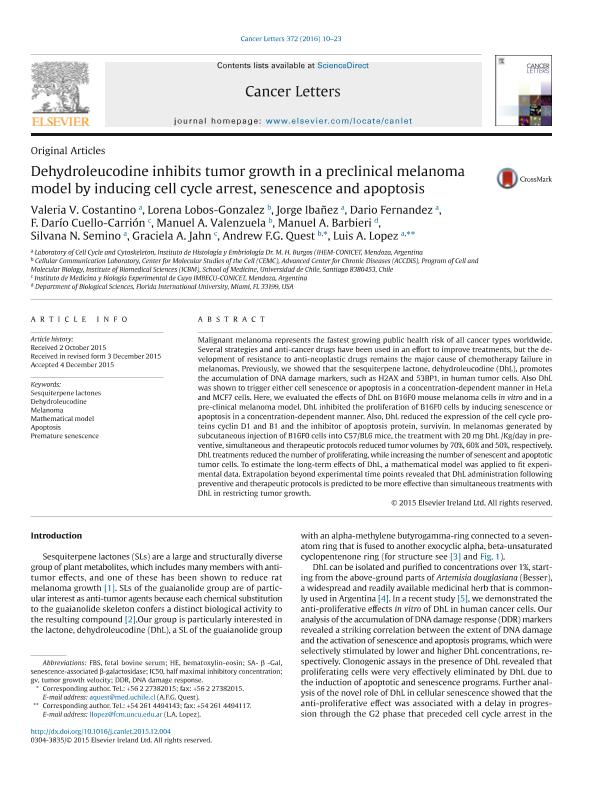Mostrar el registro sencillo del ítem
dc.contributor.author
Costantino, Valeria Victoria

dc.contributor.author
Lobos Gonzalez, Lorena
dc.contributor.author
Ibañez, Jorge Ernesto

dc.contributor.author
Fernandez, Dario
dc.contributor.author
Cuello Carrión, Fernando Darío

dc.contributor.author
Valenzuela, Manuel A.
dc.contributor.author
Barbieri, Manuel A.
dc.contributor.author
Semino, Silvana N.
dc.contributor.author
Jahn, Graciela Alma

dc.contributor.author
Quest, Andrew F.G.
dc.contributor.author
Lopez, Luis Alberto

dc.date.available
2018-06-19T18:05:55Z
dc.date.issued
2016-03
dc.identifier.citation
Costantino, Valeria Victoria; Lobos Gonzalez, Lorena; Ibañez, Jorge Ernesto; Fernandez, Dario; Cuello Carrión, Fernando Darío; et al.; Dehydroleucodine inhibits tumor growth in a preclinical melanoma model by inducing cell cycle arrest, senescence and apoptosis; Elsevier Ireland; Cancer Letters; 372; 1; 3-2016; 10-23
dc.identifier.issn
0304-3835
dc.identifier.uri
http://hdl.handle.net/11336/49351
dc.description.abstract
Malignant melanoma represents the fastest growing public health risk of all cancer types worldwide. Several strategies and anti-cancer drugs have been used in an effort to improve treatments, but the development of resistance to anti-neoplastic drugs remains the major cause of chemotherapy failure in melanomas. Previously, we showed that the sesquiterpene lactone, dehydroleucodine (DhL), promotes the accumulation of DNA damage markers, such as H2AX and 53BP1, in human tumor cells. Also DhL was shown to trigger either cell senescence or apoptosis in a concentration-dependent manner in HeLa and MCF7 cells. Here, we evaluated the effects of DhL on B16F0 mouse melanoma cells in vitro and in a pre-clinical melanoma model. DhL inhibited the proliferation of B16F0 cells by inducing senescence or apoptosis in a concentration-dependent manner. Also, DhL reduced the expression of the cell cycle proteins cyclin D1 and B1 and the inhibitor of apoptosis protein, survivin. In melanomas generated by subcutaneous injection of B16F0 cells into C57/BL6 mice, the treatment with 20 mg DhL /Kg/day in preventive, simultaneous and therapeutic protocols reduced tumor volumes by 70%, 60% and 50%, respectively. DhL treatments reduced the number of proliferating, while increasing the number of senescent and apoptotic tumor cells. To estimate the long-term effects of DhL, a mathematical model was applied to fit experimental data. Extrapolation beyond experimental time points revealed that DhL administration following preventive and therapeutic protocols is predicted to be more effective than simultaneous treatments with DhL in restricting tumor growth.
dc.format
application/pdf
dc.language.iso
eng
dc.publisher
Elsevier Ireland

dc.rights
info:eu-repo/semantics/openAccess
dc.rights.uri
https://creativecommons.org/licenses/by-nc-sa/2.5/ar/
dc.subject
Apoptosis
dc.subject
Dehydroleucodine
dc.subject
Mathematical Model
dc.subject
Melanoma
dc.subject
Premature Senescence
dc.subject
Sesquiterpene Lactones
dc.subject.classification
Otras Ciencias Biológicas

dc.subject.classification
Ciencias Biológicas

dc.subject.classification
CIENCIAS NATURALES Y EXACTAS

dc.title
Dehydroleucodine inhibits tumor growth in a preclinical melanoma model by inducing cell cycle arrest, senescence and apoptosis
dc.type
info:eu-repo/semantics/article
dc.type
info:ar-repo/semantics/artículo
dc.type
info:eu-repo/semantics/publishedVersion
dc.date.updated
2018-06-13T16:53:04Z
dc.journal.volume
372
dc.journal.number
1
dc.journal.pagination
10-23
dc.journal.pais
Irlanda

dc.description.fil
Fil: Costantino, Valeria Victoria. Consejo Nacional de Investigaciones Científicas y Técnicas. Centro Científico Tecnológico Conicet - Mendoza. Instituto de Histología y Embriología de Mendoza Dr. Mario H. Burgos. Universidad Nacional de Cuyo. Facultad de Cienicas Médicas. Instituto de Histología y Embriología de Mendoza Dr. Mario H. Burgos; Argentina
dc.description.fil
Fil: Lobos Gonzalez, Lorena. Universidad de Chile; Chile
dc.description.fil
Fil: Ibañez, Jorge Ernesto. Consejo Nacional de Investigaciones Científicas y Técnicas. Centro Científico Tecnológico Conicet - Mendoza. Instituto de Histología y Embriología de Mendoza Dr. Mario H. Burgos. Universidad Nacional de Cuyo. Facultad de Cienicas Médicas. Instituto de Histología y Embriología de Mendoza Dr. Mario H. Burgos; Argentina
dc.description.fil
Fil: Fernandez, Dario. Consejo Nacional de Investigaciones Científicas y Técnicas. Centro Científico Tecnológico Conicet - Mendoza. Instituto de Histología y Embriología de Mendoza Dr. Mario H. Burgos. Universidad Nacional de Cuyo. Facultad de Cienicas Médicas. Instituto de Histología y Embriología de Mendoza Dr. Mario H. Burgos; Argentina
dc.description.fil
Fil: Cuello Carrión, Fernando Darío. Consejo Nacional de Investigaciones Científicas y Técnicas. Centro Científico Tecnológico Conicet - Mendoza. Instituto de Medicina y Biología Experimental de Cuyo; Argentina
dc.description.fil
Fil: Valenzuela, Manuel A.. Universidad de Chile; Chile
dc.description.fil
Fil: Barbieri, Manuel A.. Florida International University; Estados Unidos
dc.description.fil
Fil: Semino, Silvana N.. Consejo Nacional de Investigaciones Científicas y Técnicas. Centro Científico Tecnológico Conicet - Mendoza. Instituto de Histología y Embriología de Mendoza Dr. Mario H. Burgos. Universidad Nacional de Cuyo. Facultad de Cienicas Médicas. Instituto de Histología y Embriología de Mendoza Dr. Mario H. Burgos; Argentina
dc.description.fil
Fil: Jahn, Graciela Alma. Consejo Nacional de Investigaciones Científicas y Técnicas. Centro Científico Tecnológico Conicet - Mendoza. Instituto de Medicina y Biología Experimental de Cuyo; Argentina
dc.description.fil
Fil: Quest, Andrew F.G.. Universidad de Chile; Chile
dc.description.fil
Fil: Lopez, Luis Alberto. Consejo Nacional de Investigaciones Científicas y Técnicas. Centro Científico Tecnológico Conicet - Mendoza. Instituto de Histología y Embriología de Mendoza Dr. Mario H. Burgos. Universidad Nacional de Cuyo. Facultad de Cienicas Médicas. Instituto de Histología y Embriología de Mendoza Dr. Mario H. Burgos; Argentina
dc.journal.title
Cancer Letters

dc.relation.alternativeid
info:eu-repo/semantics/altIdentifier/doi/http://dx.doi.org/10.1016/j.canlet.2015.12.004
dc.relation.alternativeid
info:eu-repo/semantics/altIdentifier/url/https://www.sciencedirect.com/science/article/pii/S0304383515007405
Archivos asociados
